Mastering the Online Learning: 2 Lucrative eLearning Business Models
The pandemic fuelled the eLearning industry and sparked a ton of innovative business ideas. But having a great business idea is just a part of success. The eLearning business model of your edTech startup is more significant; it must be sustainable to succeed.
Are you planning to build an eLearning business like an online tutoring marketplace, course-selling marketplace, or even a language learning marketplace like Duolingo?
To build a stable business, reach a broad user base, and grow revenue, you must choose your eLearning business model smartly.
eLearning business models
The eLearning market is one of the most crowded places out there. Without the right eLearning business model, your business venture might sink before it launches.
Before we get into the most profitable business models, what are eLearning business models exactly?
An eLearning business model is a blueprint or a framework that clearly states everything about your business, its value propositions, and how it generates revenue. In short, an eLearning business model is a roadmap to your business plan and helps outline the long-term value of your business.
Let’s explore the 2 popular and profitable eLearning business models:
Pay-per- course Model
The business model of the newest eLearning businesses or marketplaces chooses pay-per-course. It is relatively simple: tutors or instructors create courses, set a price, and learners can directly purchase it.
Here are the advantages and disadvantages of this business model.
Advantages
- Simple and straightforward business model. There is less commitment needed from the learner side. Pay for individual classes and courses, and the commitment ends there. If they wish, they can always come back to purchase more and continue enjoying the learning experience.
- Upselling becomes effortless when you bundle classes or courses of similar niches into bundles to sell them at premium prices.
- Learners do not feel overwhelmed by the volume of course material and the price they must consume.
- Monetization is easy; a successful eLeanring business can thrive with very few learners who are willing to splurge premium prices.
Disadvantages
- As no recurring revenue is involved, you need to find the correct price whenever they build a course or class.
- Ongoing creation of fresh content is important for maintaining a steady stream of earnings.
Examples of pay-per-class or course model eLearning platforms include Udemy, edX, Coursera etc.
Subscription-based eLearning business model
The subscription-based business model is another popular eLearning business model where you make all the learning material available to all learners who pay the subscription fee. You can build two or three subscription packages or just one package according to your needs.
Here are the advantages and disadvantages of this business model:
Advantages
- A predictable and recurring source of revenue with monthly subscription renewals.
- Business growth is easily tracked and implemented for seamless monitoring.
- Affordable subscription fees are a low entry barrier that will bring in more learners.
- Can offer more value-based services to learners and differentiate the services.
Disadvantages
- Churn rates can go higher. You might have spent a lot of money on gaining a learner only to lose him a couple of months later.
- Need to create ongoing content than the per-class model.
- The client size of your eLearning business must be large enough to generate a decent amount of revenue. Otherwise, you need to keep your subscription prices really high.
Examples of subscription-based eLearning platforms include Skillshare.
Freemium business model
Freemium business models are of different types, like ad-based and donation-based. While it isn’t common for eLearning businesses to use an ad-based free business model, it isn’t impossible.
You just need to find relevant places where you can embed ads on your website or in course materials like videos, PDFs etc.
Instead of ads, you can run your eLearning business from the revenue you receive from donations. For example, if your online course or classes target a broad market that offers high value to learners to attain specific skills or solve real-life problems, you can successfully implement this business model.
Advantages
- If there is a decent-sized audience willing to pay for an eLearning business for your niche, you can start collecting donations to get started. After your website goes live, the same people who donated can become your first set of learners and spread the word to help you expand your learner base.
- You can tap the talent of experts who are experts in their field while building an eLearning business using this business model.
- You can teach a broad client base with this freemium business model, as none of them have to pay you in the beginning.
Disadvantage
- The business model limits your ability to become rich; your financial benefits depend on the grace of the donors.
- It is not a sustainable business model, but it can work great when combined with other business models
One example of an eLearning business adapting this business model is Khan Academy.
Revenue sharing or commission business model
Another popular business model, a sub-division of the pay-per-course and freemium models, is the revenue-sharing model. This is basically a performance-based income model where the course marketplace takes a share of the instructor’s revenue.
For example, Udemy splits its revenue with instructions for paid courses when a learner enrolls in a course. When a learner buys an online course through Udemy’s paid ads on Google or any other paid channels, Udemy earns 25% as commission.
If the student visits the website and buys a course without a reference link or coupon code, the educator and Udemy share 50% of the revenue.
When the learner buys the course through a coupon code or reference link, the educator can keep 97% of the revenue, and Udemy earns 3% of the revenue.
Which is the best eLearning Business Model?
Now that we have explored 2 popular eLearning business models, it’s time to choose which business model is best suited for you.
Well, the answer depends on your business type, your requirements and what you are trying to achieve.
- If you want to increase your revenue and can afford to create fresh content monthly, you can choose the pay-per-class or course business model. Whereas, if you want to avoid creating the content yourself, you can consider building marketplaces and allowing tutors to do it independently, just like platforms like Udemy do.
But with this business model, the revenue you can generate will fluctuate, and you will keep finding new ways to get more learners every month. A well-crafted marketing strategy is critical for the success of this business model.
- If you are looking to earn recurring and sustainable revenue, you can choose the subscription model. However, you must ensure that you offer maximum value to your learners with high-quality content. The business model needs to create more content than the pay-per-class model.
- If you aren’t sure whether your eLearning business idea is in demand and has a sizable audience, you can choose the freemium model and go for donation-based mode. There are great chances that you can make money through donations to get started; Khan Academy has already proven that.
Conclusion
The very first step when building an eLearning business is to choose your business model. Pinlearn can be your Tech partner if you are getting started with starting an eLearning business or an online tutoring business. Get in touch with our expert team to establish your own online marketplace platform and scale your business.




